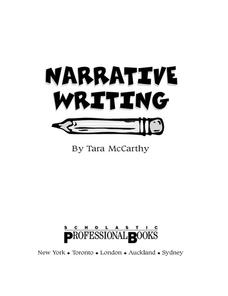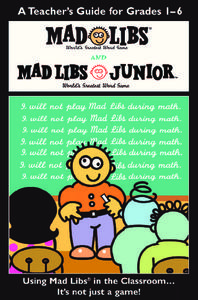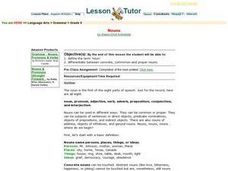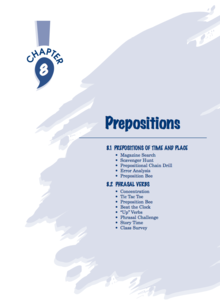Collaborative Learning Project
Simple to Complex Sentences
Such a creative game idea, this activity might actually make grammar fun! Learners play a modified game of connect-four by identifying the grammatical name for different words and phrases and then working them into simple sentences to...
Florida Center for Reading Research
Vocabulary: Word Meaning, Dictionary Digs
Young scholars dig through dictionaries to uncover the wealth of information they provide. Using the included graphic organizer, children learn about target words by finding their parts of speech, pronunciation, definition, synonyms, and...
Curated OER
Possessive Adjectives
You could use this resource with your young native English speakers or your English language learners. They practice using possessive adjectives like my, your, his, her, its, our, and their. First they study a chart that compares...
Scholastic
Narrative Writing
If you're looking to start a unit based around narrative writing, make sure to consider this resource while you're planning. This book covers five topics: writing personal narratives, writing narratives about others, writing...
Jen London
Julius Caesar Funeral Speech Essay Assignment
"Romans, countrymen, and lovers! Hear me for my cause." "Friends, Romans, countrymen, lend me your ears!" As part of a study of William Shakespeare's Julius Caesar, individuals as asked to compare the funeral speeches of Brutus and...
Poetry4kids
How to Write an Alliteration Poem
Learners follow five steps to compose an alliteration poem. They choose one consonant and brainstorm as many nouns, verbs, and adjectives they can think of to create rhyming sentences that come together in a poetic fashion.
English With Jennifer
Design Team Challenge: A Pair Activity to Practice Prepositions of Place
Test your pupils' skills with indoor decorating while finding out how well they understand prepositions of place. After practicing living room vocabulary, pairs furnish a room by drawing in items. They then present their room to the...
Curated OER
Mad Libs
Students complete language arts activities such as radio broadcasting, writing letters, write directions, rhyming sentences, and a lot more. In this language arts lesson plan, students also complete mad libs.
Savvas Learning
Nouns
Singular and plural. Count and noncount. Nouns are the focus of this 19-page grammar packet. Language learners complete a series of exercises ranging from fill-in-the-blank questions to word puzzles and more in order to further...
Savvas Learning
Prepositions
Learn about grammar the fun way! Eight activities about prepositions of time and place and phrasal verbs are sure to intrigue learners of all levels. Each activity requires minimal materials and set up, but will pay off in skills and...
Bermingham City Schools
Opinion Writing
It's no secret that children can be very opinionated, but rather than fight against this natural tendency, embrace it with this primary grade writing project. After a shared reading of a children's book about...
Mobile Education Store
StoryBuilder for iPad
Invite your kids to tell all sorts of stories with this interactive app. Learners view images and record their own voices as as they create short narratives to go along with the images. The app provides plenty of...
Lesson Plans
Analogy of the Cell Project
Intended to supplement your existing cell function and organelle lessons, pairs work together to develop a real-world analogy for cell structures. In addition to writing paragraphs about the comparison, each group will make a short...
Scholastic
What’s the Good Word? Etymology Project Guidelines
Who named the shapes, or the days of the week? Should words be removed from the dictionary if they're no longer commonly used? Are there too many words in the English language? Language arts students explore these and additional...
SUNY Empire State College
Empire State College: How Does a Sentence Make Sense?
This resource explains importance of the agreement of elements in sentences and covers agreement of nouns, verbs, pronouns, adjectives, and adverbs. Exercises included. L.11-12.3a Syntax
Annenberg Foundation
Annenberg Learner: Syntax Store
The colors listed in the boxes represent different parts of speech: noun, verb, adjective, adverb, etc. Figure out which colors represent which part of speech and then use the colors to create proper sentences.
Robin L. Simmons
Grammar Bytes: Irregular Verbs
Choose the correct form of the verb to complete the sentence.
















